
Head for Saturn: Examining the charged imagery behind one of SEGA’s most notorious advertisement campaigns
The image of a bald woman often provokes feelings of shock or curiosity. Western preconceived gender norms tie a woman’s hair into her sexuality almost as much as her figure or facial features, and its absence implies a variety of (mostly negative) assumptions. The Head For Saturn advertisement campaign effectively utilized this imagery to market the SEGA Saturn through its use of innuendo. Though likely unintentional, this charged imagery used in the context of selling a piece of technology summons themes of spirituality, understanding, and rebellion. Furthermore, the Head For Saturn advertisement series altered the lens through which video games were viewed, acknowledging the audience’s deep connection to these products and maturing how the industry viewed itself.
Like Nothing Else on Earth

Figure 1.[1]
In preparation for the launch of their new console, the SEGA Saturn, in mid-1995, SEGA produced two concurrent advertisement campaigns: the It’s Out There video, made by Goodby Silverstein & Partners, and the print advertisement series Head For Saturn, made by the Mednik group.[2] Both advertisement series utilized similar imagery, though they read considerably differently in tone. It’s Out There opens with a young Caucasian woman with a shaved head, framed from the neck up (Fig. 2). Three blue rings float above her brow, similar to how rings (like those of the planet Saturn) orbit celestial bodies. The camera orbits the X axis, locked on the woman while she begins her monologue, setting up the video’s showcase of Saturn software. The rotation on the X axis cuts away regularly, showing the model from multiple angles, though almost always from the torso up. During these cutaways, she loses herself in fits of laughter, beckons the viewer closer with her finger, runs her hands over the rings affixed to her head, and bursts into fits of anger and ecstasy. The video sometimes switches to a harsh red and black film negative. These actions contrast heavily against her monotone delivery of the lines during the central orbiting sequence and the soft blue and white lighting with a backdrop of clouds.[3]
What follows is a breakaway to several shorter advertisements, with the woman appearing between breaks to continue her monologue: “Thank you for your attention. Now, it is time to explore your inner realm.” “Now, you may return to the world as you know it.”[4]

Figure 2.[5]
In Fig. 1, the model (Hannah Syn)[6] is framed from the shoulders upwards. Her expression is vacant and calm. Rings orbit her cleanly shaven head and thick clouds swirl in the background. The color is muted, more so than in It’s Out There, which incorporates a more drastic contrast of whites and blues. Fig. 1 is greyscale, excluding the model’s blue irises. The model appears to be illuminated by a single light source coming from her left, casting a shadow over the right side of her face—a possible allusion to celestial bodies being illuminated by a central source, e.g., a star.
In the foreground, the words “Head For Saturn” sit in the center of the page, while the SEGA Saturn console subtitled with the text “It’s Out There” sits centered at the base of the page. Situated around the page are several orbs containing screenshots of SEGA Saturn games (Bug!, Virtua Fighter, Daytona USA, Clockwork Knight, and the console’s box art).[7] The orbs vary in size and position, possibly representing satellite objects, like moons orbiting a planet—or, in this case, the woman’s head.
Fig. 3 uses the same model as Fig. 1, though the scene has been recolored with a blue scale on the left page. Her eye color is more prominent in this rendering, though the portrait remains otherwise unchanged.
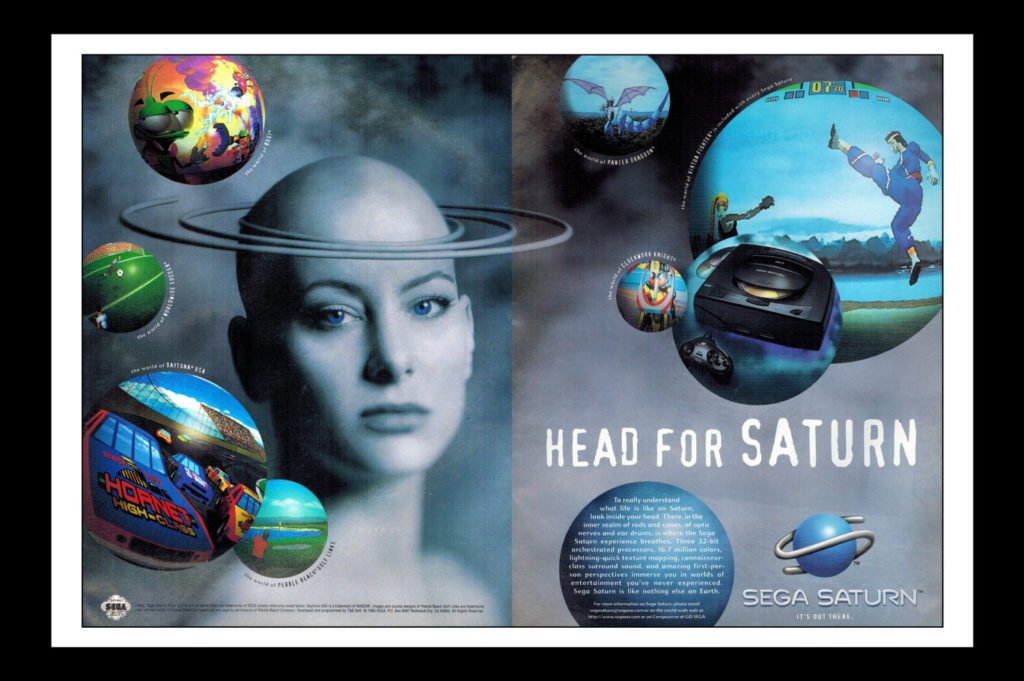
Figure 3.[8]
The advertisement itself has undergone an expansion, now being a two-page spread. Orbs have been redistributed, showing several of the same games as before, as well as others. Once again, these orbs vary in size and placement, orbiting off the left-hand page and onto the right. The right-hand page also contains the “Head For Saturn” and “SEGA Saturn—It’s Out There” texts.
Another orb sits at the base of the right page. Unlike the others, this sphere contains text, reading:
To really understand what life is like on Saturn, look inside your head. There, in the inner realm of rods and cones, of optic nerves and ear drums, is where the Sega Saturn experience breathes. Three 32-bit orchestrated processors, 16.7 million colors, lightning-quick texture mapping, connoisseur-class surround sound, and amazing first-person perspectives immerse you in worlds of entertainment you’ve never experienced. Sega Saturn is like nothing else on Earth.[9]
Fig. 4 and Fig. 5 swap models but keep the same setting as Figs. 1 and 3. In Fig. 4, actress Ione Skye is modeled.[10] However, Skye’s full body is in frame, as opposed to the portrait framing of the model used in Figs. 1 and 3. Her body is blurred slightly from the chest down, suggesting motion or wind. While the model from It’s Out There could be seen wearing a white wrap around her breasts and torso, clothing was never overtly displayed in the first advertisements of the Head For Saturn series. Skye, by comparison, has been draped in a flowing white gown. The robe ties behind her neck and hangs low, though, because of the positioning of her arms (outstretched in front of her, cupping an orb in her hands), no real tease of her skin or figure is given. She dons a shaved head, complete with the set of three rings, and spheres containing screenshots of SEGA Saturn games orbit the scene. Skye holds one of these orbs in her outstretched hands, seemingly able to levitate it while she looks out, engaging the viewer.

Figure 4.[11]
In the left-hand margin, two texts run concurrently. The first, written in blue and in all-caps, is a brief attributed to Skye, reading, “Labels are tired. They’re an easy way for lazy people to define you without ever really knowing you. Actress. Somebody’s daughter. Somebody’s wife. That doesn’t even begin to tell you what I’m all about.”[12]
In white font, running between the segmented bits of Skye’s text, reads:
Bits. Polygons. MIPS. Labels. Sega Saturn isn’t about labels. We could spend all day talking about how it shares the same architecture as $20, 000 arcade systems, and how Sega Saturn pumps the hottest arcade titles straight to your reflexes for a fraction of the cost. We could go on and on about how its gameplay experience grabs you and pulls you in, but all those words still don’t tell you what the Sega Saturn experience is really like. To understand that, you have to find out for yourself. Don’t be lazy. Don’t accept somebody else’s definitions. Even ours. While we use phrases like “the best games are only on Saturn,” and “this Christmas, Sega will have the most electrifying library of exclusive games on the planet,” you should form your own opinions from first-hand experience. Then you’ll truly know what it’s like on Saturn.[13]
This margin is footed with “Sega Saturn—Go There,” while the “Head For Saturn” text is centered just above Skye’s head.
The final advertisement from this series mirrors Fig. 4 in layout, though, instead of using a female model, it features musician Ice Cube. Like Skye’s advertisement, the right margin is reserved for text. The text, again, is an intertwined message, with Ice Cube’s monologue featured in an all-caps blue font while SEGA’s part is in a smaller white font. Ice Cube’s text reads, “Maybe you think you know who I am. How I see things. Or how I feel. Maybe if I write it, or get on the mike, you’ll understand exactly what I’m like… I don’t think so.”[14] The white text reads:
People are always coming up to us at Sega and asking, “why are you so angry!” Okay, no one’s ever asked us that. But CHECK IT: Sega Saturn is new. So if you think you know what it’s like, IT’S NOT LIKE THAT. It shares the same architecture as $20, 000 arcade systems, but Sega pumps the hottest arcade titles straight to your reflexes for a fraction of the cost. You’re welcome. With a gameplay experience that grabs you and pulls you in, it’s no wonder the best games are only on Sega Saturn. Like intense sports titles with everything but the jock itch. And this Christmas, Sega Saturn will have the most electrifying library of EXCLUSIVE games on the planet. Games no one else has. So don’t go thinking you know what Sega Saturn is like before you’ve even experienced it. And never judge a package by its rapper.[15]
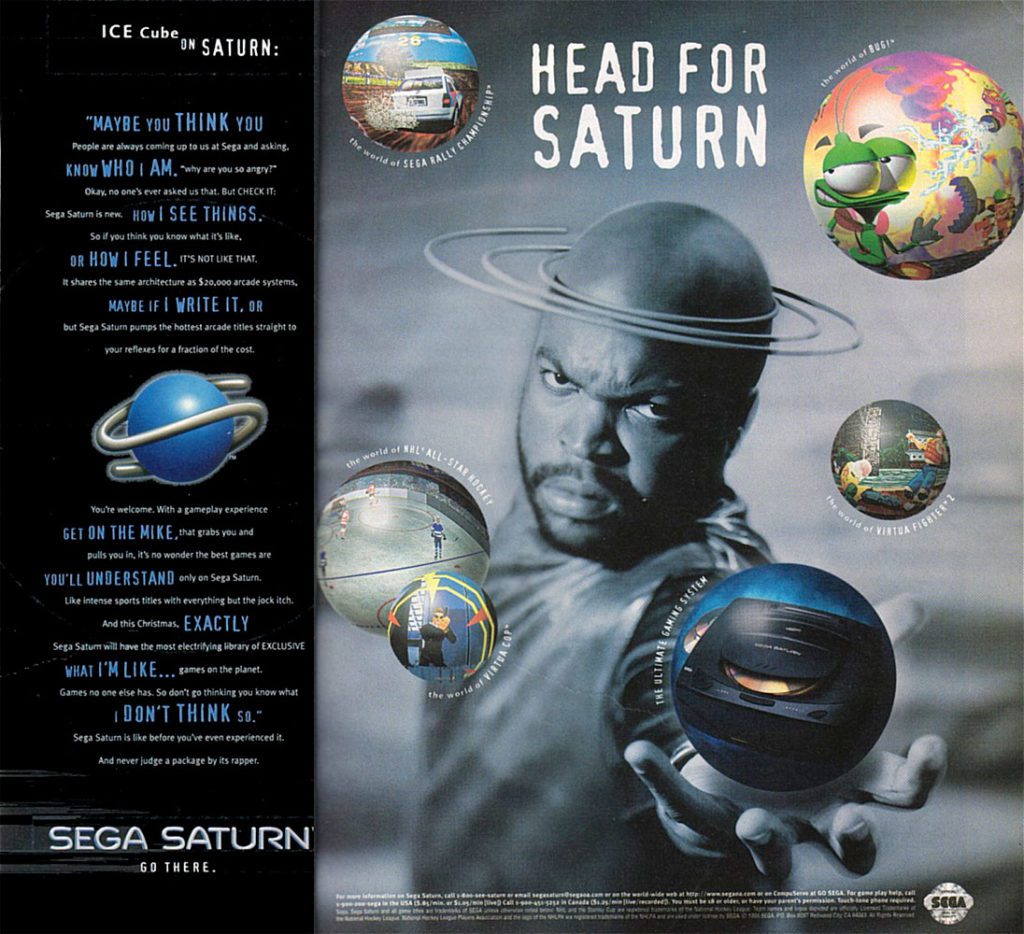
Figure 5.[16]
The main window of the advertisement shows Ice Cube from just above the waist. Like Skye’s advertisement, around the focal point is blurred, though Ice Cube does not appear to be subject to the same wind elements as Skye. The unfocused backdrop looks similar to the clouds seen in previous advertisements, but Ice Cube does not wear baggy attire that could suggest movement. Instead, he wears a simple t-shirt.
Orbs with screenshots of various games float around the scene. Ice Cube reaches out, holding one featuring an image of the SEGA Saturn in his hand. Three rings orbit his head, and the “Head For Saturn” text is placed center-top, just above Ice Cube’s (shaved) head.
The core visual themes of the Head For Saturn advertisement series include models with shaved heads and celestial imagery. Furthermore, as we’ll explore in the coming segments, Head For Saturn features models not typical of gaming advertisements of the era[17],[18]. Text (Figs. 4 and 5) prompts readers to challenge their preconceived notions of a person (Skye or Ice Cube) or video games (produced by SEGA). The tagline “It’s Out There” furthers this narrative, though, even when referencing the models sans text, the images suggest consuming video games from a more thoughtful or intellectual standpoint rather than just a hobbyist one. No one is actually playing the SEGA Saturn in these advertisements, nor is there any mention of playing video games by the models. There are no controllers or screens pictured. Instead, the games orbit their heads, as if suggesting they are realities reachable to those open-minded enough to access them.
Ken Loh, creator of the Head For Saturn advertisements, explained in a 2019 interview that his employer, the Mednik Group, had been creating print advertisements for SEGA for several years prior to 1995.[19] Loh stated that SEGA encouraged innuendo, giving them the freedom to pitch bizarre and edgy imagery (Fig. 6).[20] Loh and copywriter Perter Thornburgh devised the idea for the rings and shaved head, though Loh credits Thornburgh with the “Head For Saturn” tagline.[21] The advertisements were meant to be quirky, catching one’s attention while conveying that the SEGA Saturn was available for purchase and emphasizing the “head” concept.[22]
The campaign’s initial run (Fig. 1 and Fig. 3) intentionally left the model’s identity anonymous. The second run (Fig. 4 and Fig. 5) used celebrity endorsement by way of faces that were recognizable, but not too “mainstream,” as they wanted to present the console as “alternative.”[23]
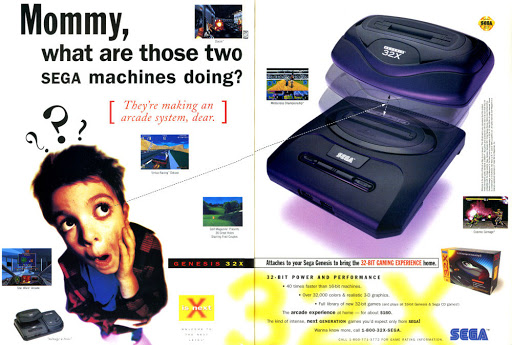
Figure 6.[24]
Preconceived Notions
While one could dismiss the Head For Saturn series as a clever pun, there are deeper meanings associated with these images. Considering Niculescu’s study of women with shaved heads and the societal values assigned to hair’s role regarding sexuality and gender, the Head For Saturn series has several implications.
The most prominent aspect of the advertisements are the models’ shaved heads. While a man with a shaved head is hardly uncommon, for women, the suggestions are more intrinsic.[25] The stylistic, personal, or medical reasons for shaving one’s head are as varied for women as they are for men. Niculescu explains:
The shaven head of the Buddhist monastic, in this time and North American culture is much more normal for men and much more radical for women . . . It is a greater renunciation for women, as women often spend so much more time with enhancing their appearance.[26]
One may lose their hair due to medical treatment or they may shave their hair for stylistic, practical, or political reasons, e.g., joining the military, combat sports, or as a symbol of counterculture.[27] Niculescu tables theories as to why these changes are more radical for women than men. For one, features like hair and nails are almost as tied to symbols of gender and sexuality as features like hips, lips, and breasts.[28] While countercultural attitudes could be assigned to the models’ shaved heads, especially considering the accompanying text on the side of Skye’s advertisement or Loh’s comments on selling the SEGA Saturn as an “alternative” product, the lack of other “punk” or aggressive imagery (aside from the all-caps font) makes this unlikely. Furthermore, medical or military reasoning can be dismissed in light of the dress and décor used in the scene. Thus, we’ll explore the spiritual allusions, Buddhism in particular.
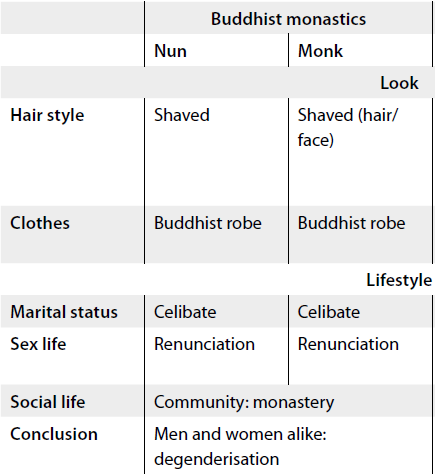
Figure 7.[29]
In Niculescu’s table[30] (Fig. 7), we can see that Buddhist nuns wear a Buddhist robe and don a shaved head, identical to their male counterparts. Their lifestyle incorporates the renunciation of marriage and sex, resulting in a degenderized community.
Themes of renunciation in Buddhist tradition could be contrasted against the text in Fig. 4 and Fig 5. SEGA claims that one must abandon all pre-conceived notions of the SEGA Saturn to truly understand it. This message is amplified by the woman in Figs. 1 and 3, as well as Skye in Fig. 4, because of the sacrifice associated with a woman losing her hair. While placing the rings around Ice Cube’s head in Fig. 5 prop up the “head” innuendo, the meaning of the act goes deeper for the women in the Head For Saturn series. Furthermore, while Ice Cube is still dressed normally (from the waste up) in his advertisement, the women have sacrificed part of what Western society deems an essential component of a woman’s sexuality—their hair.[31] It captures one’s attention right away because, in Western culture, a woman with a shaved head is a charged statement.[32] Viewers dissect the image, looking for a reason why these women have lost their hair. Niculescu recounts the story of a former Buddhist nun returning from Asia to America:
Wearing lay clothes but with hair still not grown out . . . I could see very clearly by people’s facial reactions of fear and pity that what I was being ‘seen as’ were values and messages that I was not expressing at all: a convict, a chemotherapy patient, a violent neo-Nazi, or militant lesbian, denying ‘the feminine’, or someone who had been abused in some way.[33]
Loh could have created a series of advertisements in a church with male monks bowing to a SEGA Saturn effigy or placed the orbs in space, orbiting the planet Saturn. Instead, by capturing the drastic transformation a woman undergoes in surrendering herself to a spiritual practice like Buddhism, he creates a far more potent image.
The information in the table suggests that SEGA may have been considering women’s interest in gaming in the same way they considered men’s. As noted in Fig. 7, men and women are expected to take the same vows because they are renouncing the same things. Sex and gender are eliminated from the equation. For a video game advertisement in the 1990s, this is a bold prospect, as the demographics of video game consumers wasn’t fully understood at this time, nor even ten years after the Head For Saturn series ran.[34]
Life on Saturn
In her study License to Play, Chess categorizes the ways in which women were commonly situated in print video game advertisements. She found in her study of advertisements in Game Informer and Play Magazine between 2006 and 2007 that, when women did appear in advertisements, only 34% were looking out, engaging the reader.[35] This is in immediate contrast to the Head For Saturn series, where the models look out from the page.
Furthermore, Chess found that, if a female model or character was used in an advertisement, it was likely her hands were prominently featured. Citing Goffman, Chess states:
Goffman explains that, “Women, more than men, are pictured using their fingers and hands to trace the outlines of an object or to cradle it or to caress its surface (the latter sometimes under the guise of guiding it), or to effect a ‘just barely touch’ of the kind that might be significant between two electrically charged bodies” (p. 29). While on one hand there is a utilitarian purpose to holding weapons in a game where there is fighting, the use of hands, and the specificity of seeing ungloved fingers in each of these ads is telling. The feminine character in these advertisements are not so much fighting as they are displaying a weapon in a way that sexualizes them.[36]
The model in Figs. 1 and 3 does not use her hands in any way, nor are they visible. However, in Fig. 4, Skye’s hands are featured, seemingly holding a floating orb in place. It could be argued that this falls under Goffman’s definition. Curiously, while Skye’s pose does meet the criteria of ‘just barely touch’, the fact that Ice Cube in Fig. 5 holds an orb in much the same way could somewhat nullify the point.
Chess also brings up the use of smiles and non-threatening facial expressions.[37] Women were often seen smiling or exuding a calm and supportive demeanor in her sample pool. While the model is Figs. 1 and 3 isn’t exactly snarling, she is not smiling either. Her gaze communicates a state of calm, inviting viewers to explore the SEGA Saturn rather than inviting them to view her body. The same could be said about Skye in Fig. 4, though her facial expression is slightly harder to gauge. Like the model in Figs. 1 and 3, her expression is relaxed and contemplative. However, there is the hint of a frown or snarl. Coupled with the aggressive blue all-caps text in the left margin, Skye’s advertisement does read slightly differently. That said, it still avoids many of the stereotypes laid out by Chess.
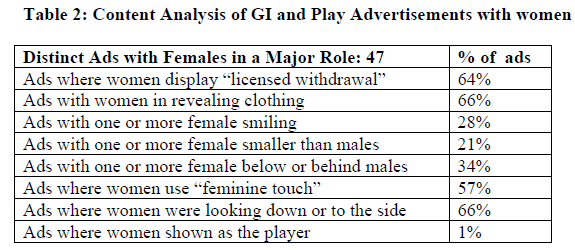
Fig. 8[38]:
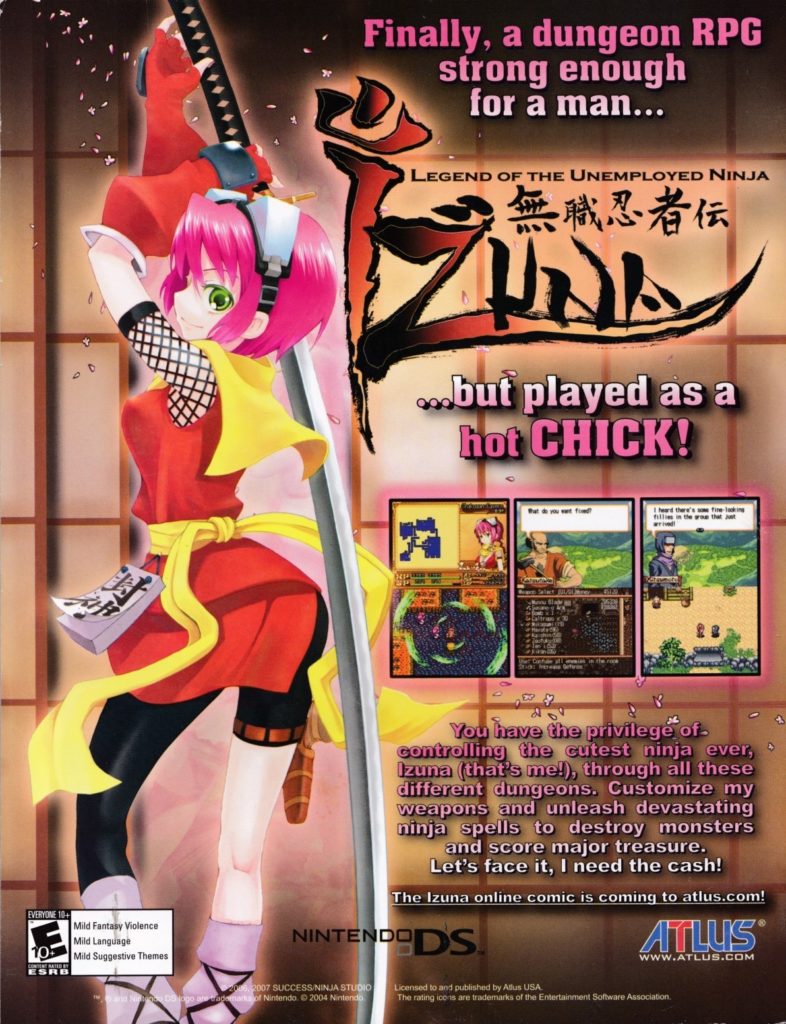
Fig. 9[39]
Chess concludes by stating that not every advertisement featuring women in her sample was sexualized. Some, like Final Fantasy and Lord of the Rings Online, featured an (almost) even mix of sexes in terms of representation and page real estate.[41] This is worth noting because, while Chess seems to suggest women displayed in a non-sexualized context were often featured alongside their male counterparts, rarely were women featured solo in an advertisement portrayed in such a way. Compared to the women in the Head For Saturn series, alone and (arguably) non-sexualized, the campaign is something of an anomaly.
Behm-Morawitz also explores representation in video game advertising. Collecting samples from Game Informer and PC Gamer, her findings of women in print video game advertisements hold similar to other studies.[42] However, her study broadens its focus to include the representation of different ethnicities. Behm-Morawitz highlights that Black male models or characters appeared in video game advertisements less than half as often as Caucasian characters or models.[43] Furthermore, when Black males were featured, they were often depicted as athletes or criminals.[44] While Behm-Morawitz does not explicitly tackle the stereotypes of rap culture in her study, one could argue that Ice Cube’s presentation adheres to or contrasts against racial stereotypes. While not depicted as a deviant or partaking in a violent act, his facial expression is notably more aggressive than Skye’s or the model in Figs. 1 and 3, potentially negating some of the subtext of higher understanding and calmness summoned by those images. The text in the left margin of Fig. 5 could be seen as a spirited response to stereotypes, though it is hardly Fuck the Police by contrast.
It could also be argued that Fig. 5 conflicts with the rest of the Head For Saturn series. Ice Cube’s demeanor and attire are in stark contrast to the other models’. Overall, the choice to have a Black man and women as the faces of the product was progressive.[45] However, viewed separately, Fig. 5 may lack the same impact as the others because, as discussed, the absence of hair is far more charged and provocative for a woman than it is for a man.[46]
This is not to suggest SEGA should have given Ice Cube the same robe as Skye, but the image’s impact is certainly affected because of this difference. The women in Figs. 1, 3, and 4 have renounced a part of their perceived femininity, enlightening them. Ice Cube, on the other hand, speaks to preconceived notions, but does not appear to have made the same level of sacrifice.
Seeing how demographics are reflected in media can have a significant impact on our attitudes and beliefs about ourselves and others.[47] While it is understandable why video game companies portrayed women and minorities the way they did throughout the 1990s and 2000s, catering to a predominantly Caucasian male audience, it’s also understandable that they expanded their consumer base as demographics became better understood. Some ten years after the Head For Saturn series, video game advertising started to change. Chess explores the expanded targeting of women players in the late 1990s and early 2000s by video game companies.
Spurred on by what Chess refers to as the “Pink Games Movement” of the mid-90s, games aimed at young girls became commonplace.[48] The movement had mixed success, ultimately showing that a market of (young) women gamers did exist, though not every one of these games was a financial success.[49] Still, companies continued to target women into the 2000s, broadening their approach. Chess states:
While one might not ordinarily suspect that video games would be advertised in magazines such as Good Housekeeping and Real Simple, there have been a surprisingly increasing number of such advertisements in recent years. Primarily, the objects promoted in these ads have been for one of two newer Nintendo systems: the handheld gaming system the Nintendo DS Lite, and the home console system the Nintendo Wii. Since approximately spring 2006, Nintendo has begun advertising these systems in venues where women might encounter them.[50]
Some ten years earlier, the Head For Saturn series did not see the same spread outside of gaming magazines, though billboards and other public advertisements were promoted.[51] Chess maintains that these games were sold as self-improvement tools, sometimes entirely forgoing the words “video game” in the advertisement.[52] Nintendo and EA’s approach was aimed broadly at the female population,[53] but they did not specifically target female gamers like Head For Saturn.
Likewise, it’s important to contrast games belonging to the “Pink Games Movement” (Barbie: Fashion Designer), non-gamer (“productive”) female consumers (Brain Age),[54] and the Head For Saturn campaign. As Chess notes, “Instead, by using tropes of productivity and self-help, these advertisements help to reinforce gender expectations of how women are expected to play.”[55]
Exploring another of Chess’ examples, Nintendo’s My Wii Story campaign engaged consumers (primarily women) by asking them to reflect on the impact of the Nintendo Wii console on their lives.[56] Stories of coming together for family game nights and creating memories with their kids were prominent in this campaign. However, there was little reflection of personal use. Why these games were fun to play, whether they would play alone, or whether personal experiences in these virtual spaces had an impact on their outlook were not prominently featured.[57] Instead, they focused on the maternal use of video games, “And in that, the subtext becomes more like emotional labor than play.”[58]
Gaming is viewed not as a hobby, but as a tool to enforce a societal definition of women: family care, betterment, and beautification. Compared with Skye’s monologue in Fig. 4, the contrast is significant. While the use of Skye and Ice Cube in these advertisements provided celebrity endorsement, it also gave personal accounts of the SEGA Saturn’s supposed effect from a real, recognizable person.[59] Holding the SEGA Saturn (orb) in her hands with the words “Actress. Somebody’s daughter. Somebody’s wife. That doesn’t even begin to tell you what I’m all about.” bolded in the left margin, it is hard to interpret Skye selling the SEGA Saturn as a beautification or family-oriented product. She is conveying that she need not conform to society’s expectations and understanding of gaming; the use of these products need not be gendered.
Cyber Punks and Digital Zen
Lim explores the meanings behind artist Nam June Paik’s famous 1974 work, TV Buddha, in his study Moving Meditation. TV Buddha is an installation video art piece comprised of a Buddha head sculpture set in front of a video monitor.[60] The video monitor shows a feed of the Buddha head in real time, prompting one to question the authenticity, or essence, of virtual representations.[61] Lim explains, “The intention of TV Buddha is to suggest the meaning of the contrast between reality and its “live” representation (reality on the screen), or what kind of meaning can be derived from it.”[62]

Fig. 10[63]
Inviting viewers to open themselves to new concepts of reality, the Head For Saturn advertisements could be seen as tackling similar themes to Paik’s work. The focus is not on the games or avatars, but rather the effect playing them has on one’s understanding. Stripped of societal labels and identity, coupled with an embrace of the digital realm, the series could be seen as alluding to yi (unconventional naturalness), a Zen Buddhist concept explained by Lim:
The term yi (unconventional naturalness) stems from Zen Buddhism and refers to transcendence from irrational secular ideas and blind stereotypes. The idea is to excel beyond what others do, what is said to be correct, and what is believed to be necessary, thereby reaching a state of freedom from common convention and general acceptance. Reaching a state of unconventional naturalness requires lowering our sense of reality and estranging ourselves from stereotypical conventions.[64]
This definition closely resembles the messaging found in the Head For Saturn series, both in the texts found in Fig. 4 and Fig. 5 and in the points tabled above regarding a woman’s shaved head. Furthermore, it is suggests the effect of interacting with the SEGA Saturn is, unlike other video games, a thoughtful or reflective experience. The SEGA Saturn seemingly attempts to blend the virtual and real worlds together, allowing players to explore their identity by way of virtual interaction.
Video games, virtual reality, and cyberspace technology were commonplace by the mid-1990s.[65] Many questions raised by artists and authors decades prior had filtered into popular culture, manifesting in reality. In her book, Cyberpunk Women: Feminism and Science Fiction, Lavigne states:
As the first wave led into the 1990s, and the need to “imagine” cyberspace faded with the rise of the Internet, certain cyberpunk novels’ use of language and imagery related to the fantastic, legendary or supernatural clearly evolved from imaginative descriptions of cyberspace to a more measured evaluation of religious organizations.[66]
The cyberpunk notion of escapism in cyberspace and the swapping of one’s body for that of an avatar’s is directly mirrored by digital media like video games, yet no video games are actually being played in the Head For Saturn series. The message is focused on the spiritual journey one undertakes through playing the SEGA Saturn rather than suggesting that players become the avatar on screen. Exploring virtual reality, Lavigne cites Balasmo: “There is little coincidence that VR emerged in the 1980s, during a decade when the body was understood to be increasingly vulnerable (literally, as well all discursively) to infection, as well as to gender, race, ethnicity and ability critiques.”[67]
Head For Saturn could be viewed through a Buddhist lens, “technofied” and warped by criteria inspired by cyberpunk literature. However, this inflates conflict between narratives of feminism and religion. Lavigne states:
Women’s novels reflect…the problematic positioning of mythology and folklore with feminist thought – feminists, in general, do not seem happy with either mythology or religion, but no alternative language has yet been produced; the cyborg has not yet truly risen as an iconic image, and within cyberpunk this little room for the goddess.[68]
On one hand, you have renunciation and higher understanding to achieve equality. On the other, you have personal expression through digital media (the SEGA Saturn). Whether Head For Saturn has more evocative feminist or religious themes (or both) through its cyberspace setting is up for debate, but the concurrent messages of surrendering one’s identity and aggressively defending it could be interpreted as somewhat at odds with one and other. The perceived themes of equality do not necessarily result in a perceived message of empowerment.
You May Return to the World As You Know It
Though the Head For Saturn campaign was an aggressive first push to market the SEGA Saturn, the tone set by the series was not evenly reinforced by SEGA throughout the rest of the console’s life.[69] For example, in SEGA’s 1996 Blood, Sweat & Tears advertisement, the 3D fighting game Fighting Vipers is prominently featured. Fighting Vipers includes a feature where combatants can hit each other to strip them of their armor. The game features eleven playable characters, including three females (one Latina, one Caucasian, and one Black). The Caucasian female character, Candy, is prominently featured in many of these clips, sometimes with her armor partially removed, showing her bare skin and undergarments.[70] The armor removal mechanic is applied to all characters; they are all objectified in the same way. The Latina and Black female characters, Jane and Grace, are also shown several times in the Blood Sweat & Tears video, though not with the same frequency or in the same undressed state as Candy.
Even if one accepts that the Head For Saturn series was a progressive experiment focused on broadening and redefining SEGA’s audience by dismantling stereotypes, SEGA’s advertising campaigns during the Saturn era showcase that they were still subject to industry norms. Reflecting on another of his creations, the Nothing Else Matters advertisement (Fig. 11), Loh stated the idea was born from a similar line of thought as the Head For Saturn campaign, utilizing innuendo and edgy imagery to emphasize the product’s appeal.[71]
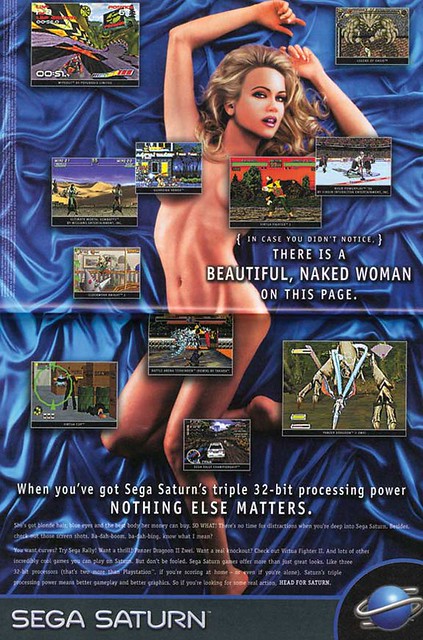
Fig. 11[72]
As mentioned, the It’s Out There series conveys a different message from the Head For Saturn series, with the model being unhinged in her enthusiasm for SEGA’s console, playing into several of the statistics laid out by Chess and Behm-Morawitz. Loh and the Mednik group did not create the It’s Out There video. Seeing as the Mednik Group was responsible for the tagline and initial image, it can be assumed that internal decisions regarding continuity at SEGA prompted Goodby Silverstein & Partners‘ interpretation. Thus, to give merit to the arguments tabled regarding equality and renunciation, the Head For Saturn series must be examined and judged on its own. One could ask how progressive (or intentional) the Head For Saturn advertisements were when they were simultaneously keen to produce advertisements like Blood, Sweat & Tears and Nothing Else Matters. In fact, the messages conveyed were likely unintentional; their impact, however, remains.

Fig. 12[73]
SEGA’s Head For Saturn series relies on the evocation of an idea. The advertisements suggest the SEGA Saturn is a console for those looking for a transformative, enlightening experience. The emphasis is not on the games, but the experience of playing them and how this subsequently alters one’s state. The Head For Saturn advertisements suggest philosophies of renunciation, surrendering one’s preconceived notions in order to gain understanding. While they stop short of suggesting gamers drop everything and become monks or nuns, the series does challenge the viewer to alter their perception of SEGA’s video games. In merely teasing the software via warped screenshots plastered across floating orbs, the images spur one to imagine what the games are truly like, keeping focus on the personal impact of the software rather than the software itself. Furthermore, with “World of” put in front of each title, one’s perceived scope of each game is greatly expanded. The melding of real models and CG assets overtly suggests the blending of realities—the real world and those experienced in video game—suggesting the two are of equal caliber, no less.
Curiously, Loh mentions his displeasure with some parts of the series. He believes the orbs featured are too harsh of a contrast with the black and white exposure of the photographs.[74] Furthermore, he wished the model in Figs. 1 and 3 had been primed with less makeup, as the natural wrinkles and contours of her skin added a “haunting” edge to the picture.[75]
In embracing the phenomenon of gaming as a lifestyle instead of just a hobby, SEGA was progressive in their view of the medium. They moved from selling toys you hooked up to your television to selling products for mature consumers capable of appreciating the medium from a different perspective. Furthermore, they extended their target consumer base beyond young Caucasian males alone, challenging the community’s definition of “gamer.” By inviting women into the equation, they did not attempt to market the Saturn as a “Pink Game” or “productivity” machine; the series acknowledged women as part of their audience.

Fig. 13[76]
In 1984, nearly 38% of computer science degrees in the U.S. were awarded to women; by 1994, that had dropped to around 28%.[77] Obviously, there was an interest in technology and computer science from both sexes, though how computers and technology could be used as weapons or personal tools in popular media largely focused on male power fantasies.[78]
Behm-Morawitz states, “In addition, history suggests that an industry’s capability to quickly respond to growing female and non-Caucasian markets is important to the future success of the industry.”[79] Behm-Morawitz highlights a few curious findings from her samples, like how Black males in advertisements were depicted acting violently 37% of the time and women were dressed provocatively 50% of the time.[80] Whether or not Head For Saturn had a positive commercial impact is unexplored in this paper, and whether or not these advertisements actually had a positive influence on non-Caucasian consumers is unknown.[81] Furthermore, the studies cited in this paper were all conducted some ten years after the SEGA Saturn’s market run. Though there has been an effort to highlight that these stereotypes were in fact the norm in video game advertising, a more in-depth study on advertising practices of the early and mid-90s would help further illuminate the series as an outlier.
While SEGA may have been marketing the Saturn to non-traditional demographics, the actual software on the console still very much adhered to genre norms. A more detailed study on whether the Saturn’s software strove to include women and minority characters would need to be conducted.
Though there are still many questions surrounding the impact of the Head For Saturn series, the fact that SEGA produced such a bold and provocative series when they did was an important step in the growth and expansion of video game culture. It stands as highly memorable if nothing else, and Loh’s work continues to be thought provoking over two decades after its inception.
[1] “Head For Saturn,” Sega Enterprises, accessed March 7, 2021, https://www.neogaf.com/threads/neogaf-official-sega-saturn-community.1507666/page-9
[2] Patrik Traynor, host. “Season 4: E2 – “Head for Saturn with Ken Loh.” Sega Saturn, Shiro! (podcast), November 4, 2019. Accessed April 11, 2021, https://segasaturnshiro.podiant.co/e/season-4-ep-2-head-for-saturn-with-ken-loh-37e0ceb272ed34/
[3] Cyber Chaos Crew. “Sega Saturn – It’s Out There (1995 Launch Commercial),” YouTube video, 8:38, 23 June, 2017, https://www.youtube.com/watch?v=cyv6ZehQyTQ&t=11s
[4] Ibid.
[5] Ibid.
[6] Peter Malek, “SHIRO! Shorts: Heads of Saturn” Accessed April 21, 2021. https://www.segasaturnshiro.com/2021/04/17/shiro-shorts-heads-of-saturn/
[7] “Head For Saturn,” Sega Enterprises.
[8] “Head For Saturn (v2),” Sega Enterprises, accessed March 7, 2021, https://www.neogaf.com/threads/neogaf-official-sega-saturn-community.1507666/page-9
[9] Ibid.
[10] “Ione Skye on Saturn,” Sega Enterprises, accessed July 30, 2021, https://www.segasaturnshiro.com/2021/04/17/shiro-shorts-heads-of-saturn/
[11] Ibid.
[12] Ibid.
[13] Ibid.
[14] “Ice Cube on Saturn,” Sega Enterprises, accessed March 7, 2021, https://www.neogaf.com/threads/neogaf-official-sega-saturn-community.1507666/page-9
[15] Ibid.
[16] Ibid.
[17] Elizabeth Behm-Morawitz, “Examining the intersection of race and gender in video game advertising,” Journal of Marketing Communications 23, no. 3 (2017): 223.
[18] Ibid, 233.
[19] Traynor, interview.
[20] Ibid.
[21] Ibid.
[22] Ibid.
[23] Ibid.
[24] “Mommy, what are those two SEGA machines doing?” Sega Enterprises, accessed April 13, 2021, http://segabits.com/blog/2014/08/02/sega-saturday-morning-ads-sega-32x-just-stick-it-in-your-genesis/
[25]Mira Niculescu, “Women with shaved heads: Western Buddhist nuns and Haredi Jewish wives: Polysemy, universalism and misinterpretations of hair symbolism in pluralistic societies,” Religion and the Body 23, (2011): 323.
[26] Ibid, 323.
[27] Ibid, 311-312.
[28] Ibid, 309, 311.
[29] Ibid, 318.
[30] Ibid, 318.
[31] Ibid, 309.
[32] Ibid, 310.
[33] Ibid, 327.
[34] T.L Stanley, “’Warcraft’ meets the ‘Housewives’; VIDEO GAMES: There’s a wide world beyond ‘Mortal Kombat’ as marketers strive to reach women as well as younger, casual players,” Advertising Age 77, no. 26 (2006): 16.
[35]Shira Chess, “License to Play: Women, Productivity, and Video Games” (PhD diss., Rensselaer Polytechnic Institute, 2009) 79.
[36] Ibid, 84.
[37] Ibid, 210.
[38] Ibid, 210.
[39] Atlus USA, “Izuna: Legend of the Unemployed Ninja.” Accessed March 7, 2021. https://vgprintads.tumblr.com/post/151841197811/izuna-legend-of-the-unemployed-ninja-ds-usa
[40] Ibid, 210.
[41] Chess, “License to Play,” 89.
[42] Behm-Morawitz, “Examining the intersection of race and gender in video game advertising,” 224.
[43] Ibid, 223.
[44] Ibid, 233.
[45] Ibid, 228.
[46] Niculescu, “Women with shaved heads,” 324.
[47] Behm-Morawitz, “Examining the intersection of race and gender in video game advertising,” 223.
[48] Shira Chess, “A 36-24-36 Cerebrum: Productivity, Gender, and Video Game Advertising,” Critical Studies in Media Communication 28, no. 3 (2011): 231.
[49] Ibid, 232.
[50] Ibid, 235.
[51] PandaMonium Reviews Every U.S. Saturn Game. “Ghen War | Reviewing Every U.S. Saturn Game | Episode 36 of 246,” YouTube video, 34:22, October 26, 2019. https://www.youtube.com/watch?v=eBP7875MKhE
[52] Chess, “A 36-24-36 Cerebrum,” 240.
[53] Ibid, 251.
[54] Ibid, 240.
[55] Ibid, 233.
[56] Ibid, 244.
[57] Ibid, 244.
[58] Ibid, 244.
[59] Traynor, interview.
[60] Tae-seung Lim, “Moving Meditation: Paik Nam June’s TV Buddha and Its Zen Buddhist Aesthetic Meaning,” Dao 18 (2019): 97.
[61] Ibid, 104.
[62] Ibid.
[63] Nam June Paik, “TV Buddha No. X,” Whitney Museum of American Art.
[64] Lim, ”Moving Meditation,” 92.
[65] Carlen Lavigne, Cyberpunk Women, Feminism and Science Fiction: A Critical Study (NC: McFarland Publishing, 2013), 115.
[66] Ibid, 114.
[67] Ibid, 62.
[68] Ibid, 130.
[69] Traynor, interview.
[70] Game Zero. “Sega 1996 Holiday Ad Campaign ‘Blood, Sweat & Tears’,” YouTube video, 5:07, 1 November, 2015. https://www.youtube.com/watch?v=uNNN8vhSrw8
[71] Traynor, interview.
[72] “Nothing Else Matters,” Sega Enterprises, accessed March 7, 2021, https://luccava.wordpress.com/2011/06/30/sega-saturn-ad-analysis/
[73] “Are There No Limits?” Sega Enterprises, accessed March 7, 2021, https://www.neogaf.com/threads/neogaf-official-sega-saturn-community.1507666/page-9
[74] Traynor, interview.
[75] Ibid.
[76] Sega Enterprises, “It’s Out There.”
[77] Lavigne, Cyberpunk Women, Feminism and Science Fiction, 160.
[78] Ibid.
[79] Behm-Morawitz, “Examining the intersection of race and gender in video game advertising,” 233.
[80] Ibid, 229, 231.
[81] Traynor, interview.
Bibliography
Allan, Kathryn. “Reviews,” review of Cyberpunk Women, Feminism and Science Fiction: A Critical Study, by Carlen Lavigne, Journal of the Fantastic in the Arts 25, no. 2–3 (2014): 367–68.
Atlus USA, “Izuna: Legend of the Unemployed Ninja.” 2007. Accessed March 7, 2021. https://vgprintads.tumblr.com/post/151841197811/izuna-legend-of-the-unemployed-ninja-ds-usa
Behm-Morawitz, Elizabeth. “Examining the intersection of race and gender in video game advertising.” Journal of Marketing Communications 23, no. 3 (2017): 220–239.
Cyber Chaos Crew. “Sega Saturn – It’s Out There (1995 Launch Commercial),” YouTube video, 8:38, 23 June, 2017, https://www.youtube.com/watch?v=cyv6ZehQyTQ&t=11s
Chess, Shira. “A 36-24-36 Cerebrum: Productivity, Gender, and Video Game Advertising.” Critical Studies in Media Communication 28, no. 3 (2011): 230–252.
Chess, Shira. “License to Play: Women, Productivity, and Video Games.” PhD diss., Rensselaer Polytechnic Institute, 2009.
Game Zero. “Sega 1996 Holiday Ad Campaign ‘Blood, Sweat & Tears’,” YouTube video, 5:07, 1 November, 2015. https://www.youtube.com/watch?v=uNNN8vhSrw8
Kartika Surya, Dita. “Sexist Ideology in SEGA SATURN Printed Advertisement.” Final Exam, Faculty of Letters and Fine Arts, Sebelas Maret University, 2011.
Lavigne, Carlen. Cyberpunk Women, Feminism and Science Fiction: A Critical Study. Jefferson, NC: McFarland Publishing, 2013.
Lim, Tae-seung.”Moving Meditation: Paik Nam June’s TV Buddha and Its Zen Buddhist Aesthetic Meaning.” Dao 18 (2019): 91–107.
Malek, Peter. “SHIRO! Shorts: Heads of Saturn.” Accessed April 21, 2021. https://www.segasaturnshiro.com/2021/04/17/shiro-shorts-heads-of-saturn/
Malek, Peter. “Saturn Lands in America!” Accessed April 12, 2021. https://www.segasaturnshiro.com/2020/05/03/saturn-lands-in-america/
Niculescu, Mira. “Women with shaved heads: Western Buddhist nuns and Haredi Jewish wives: Polysemy, universalism and misinterpretations of hair symbolism in pluralistic societies.” Religion and the Body 23 (2011): 309–332.
Olson, Beth. “Killing Us Softly 3: Advertising’s Image of Women/Game Over: Gender, Race & Violence in Video Games,” review of Killing Us Softtly 3: Advertising’s Image of Women, Media Education Foundation, 2000. & Game Over: Gender, Race & Violence in Video Games, Media Education Foundation, 2000.
Paik, Nam June. “TV Buddha No. X.” Whitney Museum of American Art, 1974–1982.
PandaMonium Reviews Every U.S. Saturn Game. “Ghen War | Reviewing Every U.S. Saturn Game | Episode 36 of 246,” YouTube video, 34:22, October 26, 2019. https://www.youtube.com/watch?v=eBP7875MKhE
Sega Enterprises. “Are There No Limits?” Accessed March 7, 2021, https://www.neogaf.com/threads/neogaf-official-sega-saturn-community.1507666/page-9
Sega Enterprises. “Head For Saturn.” Accessed March 7, 2021, https://www.neogaf.com/threads/neogaf-official-sega-saturn-community.1507666/page-9
Sega Enterprises. “Head For Saturn (v2).” Accessed March 7, 2021, https://www.neogaf.com/threads/neogaf-official-sega-saturn-community.1507666/page-9
Sega Enterprises. “Ice Cube on Saturn.” Accessed March 7, 2021, https://www.neogaf.com/threads/neogaf-official-sega-saturn-community.1507666/page-9
Sega Enterprises. “Ione Skye on Saturn.” Accessed July 30, 2021, https://www.segasaturnshiro.com/2021/04/17/shiro-shorts-heads-of-saturn/
Sega Enterprises. “Mommy, what are those two SEGA machines doing?” Accessed April 13, 2021, http://segabits.com/blog/2014/08/02/sega-saturday-morning-ads-sega-32x-just-stick-it-in-your-genesis/
Sega Enterprises. “Nothing Else Matters.” Accessed March 7, 2021, https://luccava.wordpress.com/2011/06/30/sega-saturn-ad-analysis/
Stanley, T.L. “’Warcraft’ meets the ‘Housewives’; VIDEO GAMES: There’s a wide world beyond ‘Mortal Kombat’ as marketers strive to reach women as well as younger, casual players.” Advertising Age 77, no. 26 (2006): 16.
Traynor, Patrik, host, “Season 4: E2 – “Head for Saturn with Ken Loh.” Sega Saturn, Shiro! (podcast), November 4, 2019. Accessed April 11, 2021, https://segasaturnshiro.podiant.co/e/season-4-ep-2-head-for-saturn-with-ken-loh-37e0ceb272ed34/

